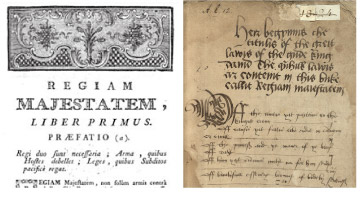1.1 The Regiam Majestatem
The Regiam Majestatem is an exceptional document worthy of an individual mention. It provides a unique record of the law in Scotland in medieval times. Although it is not clear either how or why this collection of laws was brought together into one document, it became an authoritative source of the law (with parliament ordering its publication in the early seventeenth century). Drawing on sources including native Scots law, canon and Roman law and a collection of early English laws it provides a rare example, and insight, into the nature and content of laws which had been written down (customary laws at the time were rarely written but relied on the spoken word and custom). It is also important as it provides a record from an era when many other important documentary records were destroyed during invasions by the English monarchs Edward I (1239–1307) and Edward III (1312–1377).
Whilst the accuracy of the laws and different editions have been questioned by legal researchers and scholars, the Regiam Majestatem had significant influence on the development of the Scottish legal system. Originally written by hand, the first royal licence for its printing was issued by James IV (1488–1513) in 1507. This helps illustrate the importance placed upon it. (The first Act of Parliament was printed in 1542). The development of the printing press made documents and information more readily and more cheaply available. This helped spread new ideas and information to a wider population.

